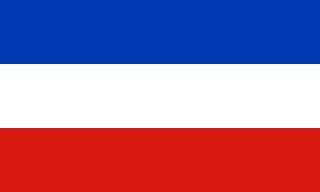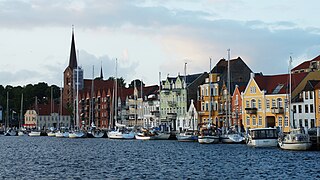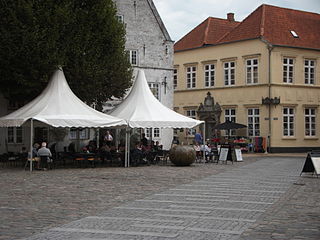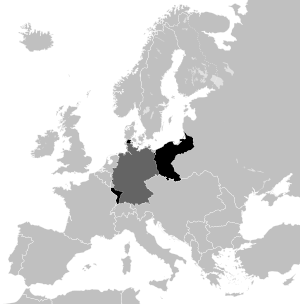
Schleswig-Holstein is the northernmost of the 16 states of Germany, comprising most of the historical duchy of Holstein and the southern part of the former Duchy of Schleswig. Its capital city is Kiel; other notable cities are Lübeck and Flensburg.

Southern Schleswig is the southern half of the former Duchy of Schleswig in Germany on the Jutland Peninsula. The geographical area today covers the large area between the Eider river in the south and the Flensburg Fjord in the north, where it borders Denmark. Northern Schleswig, congruent with the former South Jutland County, forms the southernmost part of Denmark. The area belonged to the Crown of Denmark until Prussia and Austria declared war on Denmark in 1864. Denmark wanted to give away the German-speaking Holsten and set the new border at the small river Ejderen. Prussian chancellor Otto von Bismarck concluded that this justified a war, and even proclaimed it a "holy war". He also turned to the Emperor of Austria, Franz Joseph I of Austria for help. A similar war in 1848 had gone poorly for the Prussians. With Prussia's modern weapons and the help from both the Austrians and General Moltke, the Danish army was destroyed or forced to make a disorderly retreat. And the Prussian-Danish border was moved from the Elbe up in Jutland to the creek Kongeåen.

The Duchy of Schleswig was a duchy in Southern Jutland covering the area between about 60 km north and 70 km (45 mi) south of the current border between Germany and Denmark. The territory has been divided between the two countries since 1920, with Northern Schleswig in Denmark and Southern Schleswig in Germany. The region is also called Sleswick in English.

South Jutland County is a former county on the south-central portion of the Jutland Peninsula in southern Denmark.

Aabenraa Municipality is a municipality in the Region of Southern Denmark in southwestern Denmark. The municipality has an area of 940.7 km2 and a total population of 59,051 (2016). Its largest town and the site of its municipal council is the city of Aabenraa. The mayor of the municipality is Thomas Andresen, representing the Liberal party.

Augustenborg is a town on Als Island in Sønderborg Municipality, Region of Southern Denmark in Denmark. The town lies at the head of Als Fjord. To the east is the Little Belt. Ferry service connects Augustenborg to the island of Funen from the nearby town of Fynshav.

Sønderborg Municipality, is a municipality in Region of Southern Denmark partially on the Jutland peninsula and partially on the island of Als in south Denmark, at the border with Germany. The municipality covers an area of 495.86 km2 (191.45 sq mi), and has a population of 75,264. Its mayor as of 1 January 2014 is Erik Lauritzen, a member of the Social Democratic party.

Tønder is a municipality in Region of Southern Denmark on the Jutland peninsula in south Denmark. The municipality covers an area of 1,278 km2, and has a total population of 37,777 (2018). Its mayor is Henrik Frandsen, a member of the Venstre political party.

Aabenraa or Åbenrå is a town in Southern Denmark, at the head of the Aabenraa Fjord, an arm of the Little Belt, 26 kilometres (16 mi) north of the Denmark–Germany border and 32 kilometres (20 mi) north of German town of Flensburg. It was the seat of Sønderjyllands Amt until 1 January 2007, when the Region of Southern Denmark was created as part of the 2007 Danish Municipal Reform. With a population of 16,410, Aabenraa is the largest town and the seat of the Aabenraa Municipality.

The Region of Southern Denmark is an administrative region of Denmark established on Monday 1 January 2007 as part of the 2007 Danish Municipal Reform, which abolished the traditional counties ("amter") and set up five larger regions. At the same time, smaller municipalities were merged into larger units, cutting the number of municipalities from 271 before 1 January 2007 to 98. The reform diminished the power of the regional level dramatically in favor of the local level and the central government in Copenhagen. The Region of Southern Denmark has 22 municipalities. The reform was implemented in Denmark on 1 January 2007, although the merger of the Funish municipalities of Ærøskøbing and Marstal, being a part of the reform, was given the go-ahead to be implemented on Sunday 1 January 2006, one year before the main reform. It borders Schleswig-Holstein (Germany) to the south and Central Denmark Region to the north and is connected to Region Zealand via the Great Belt Fixed Link.
The Schleswig plebiscites were two plebiscites, organized according to section XII, articles 100 to 115 of the Treaty of Versailles of 28 June 1919, in order to determine the future border between Denmark and Germany through the former Duchy of Schleswig. The process was monitored by a commission with representatives from France, the United Kingdom, Norway and Sweden.

The Province of Schleswig-Holstein was a province of the Kingdom of Prussia from 1868 to 1946.

Tønder County is a former province in Denmark, located the south-western part of Southern Jutland. Tønder County was established in 1920 following the reunification of Denmark with South Jutland following the Schleswig Plebiscites. It was dissolved in 1970 when the bulk of the county merged with three other counties to form South Jutland County. Tønder County corresponded geographically to the northern part of the former Prussian Kreis Tondern except for Hviding Herred, which had been part of Kreis Hadersleben. Kreis Tondern had in turn been established in 1867 in order to simplify the intricate administrative structures of the Duchy of Schleswig, and was formed from regions belonging to Ribe County and Løgumkloster County.

Aabenraa County is a former province in Denmark, located on the east-central region of Southern Jutland. Aabenraa County was established in 1920 following the reunification of Denmark and South Jutland following the Schleswig Plebiscites. It was dissolved in 1970 when it merged with three other counties to form South Jutland County. Aabenraa County corresponded geographically to the former Prussian Kreis Apenrade combined with the larger part of Bov Parish and Frøslev municipality. Both were transferred from Kreis Flensburg with the establishment of the current Danish-German border. Aabenraa County and Sønderborg County merged in 1932, forming Aabenraa-Sønderborg County.

Tønder is a town in the Region of Southern Denmark. With a population of 7,491, it is the main town and the administrative seat of the Tønder Municipality.

Sønderborg (Danish pronunciation: [ˈsønɐˌpɒˀ] - is a Danish town in the Region of Southern Denmark. It is the main town and the administrative seat of Sønderborg Municipality. The town has a population of 27,702, in a municipality of 74,561. In recent times, Sønderborg is a center for trade, tourism, industry, and education in the region of Southern Denmark. The town is the headquarters for several industrial companies.

Region Sønderjylland–Schleswig is the regional centre for cross-border cooperation between the municipalities of Tønder, Aabenraa, Haderslev and Sønderborg, the regional council of southern Denmark, the districts Schleswig-Flensburg and Nordfriesland, and the city of Flensburg.

The Kingdom of Denmark has existed with its current territory since 1920. The only land border of Denmark (proper) is that with Germany, with a length of 68 km (42 mi). The border along the territorial waters with Sweden runs along the Øresund for a length of about 115 km (71 mi).
Der Nordschleswiger is a German-language internet newspaper in Denmark with its main editorial office in Aabenraa and local editorial offices in Haderslev, Sønderborg, Tinglev and Tønder. The media house functions and sees itself as the mouthpiece of the German minority. It is one of two major minority media outlets in the Danish-German border region, the other one being Flensborg Avis of the Danish minority in Germany. It was the first German-language paper established in Europe following World War II.
This is a survey of the postage stamps and postal history of Holstein, Schleswig-Holstein, Schleswig and incidentally Lauenberg. Separate stamps were issued for Holstein (1850), Schleswig (1864-1867), Holstein (1864-1866), Schleswig-Holstein (1865) and Schleswig (1920).


















